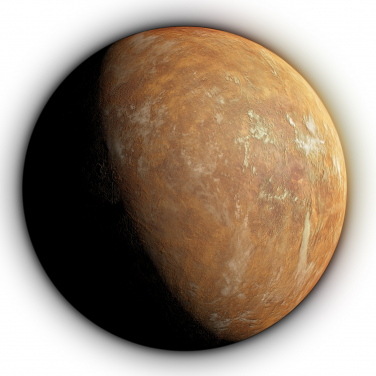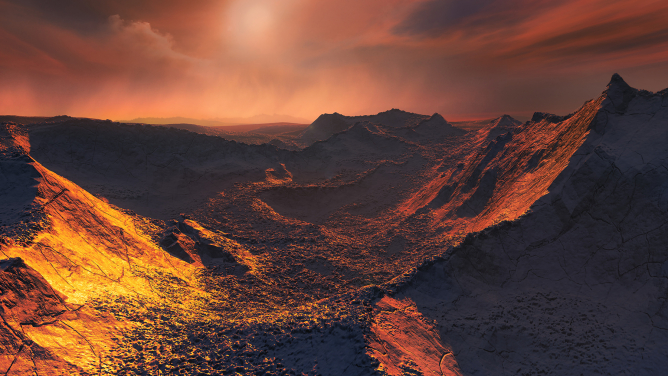Media
Planet discovered orbiting the second closest stellar system to the Earth
15 Nov 2018

Graphic representation of the relative distances to the Graphic representation of the relative distances to the nearest stars from the Sun. Barnard’s star is the second closest star system, and the nearest single star to us. (Image credit: IEEC/Science-Wave - Guillem Ramisa. Licence: Creative Commons with Attribution)

Artist’s impression of the planet under the orange tinted light from Barnard’s star. (Image credit: IEEC/Science-Wave - Guillem Ramisa. Licence: Creative Commons with Attribution)

Artist’s impression of the planet’s surface. (Image credit: ESO - M. Kornmesser. Licence: Creative Commons with Attribution)

Graphic representation of the relative distances to the Graphic representation of the relative distances to the nearest stars from the Sun. Barnard’s star is the second closest star system, and the nearest single star to us. (Image credit: IEEC/Science-Wave - Guillem Ramisa. Licence: Creative Commons with Attribution)
- 1 / 3
- 2 / 3
- 3 / 3
An international team of astronomers led by Dr. Ignasi Ribas of the Institute of Space Studies of Catalonia (IEEC) and Institute of Space Sciences (ICE, CSIC) in Spain and including Dr. Man Hoi Lee from Department of Earth Sciences and Department of Physics, the University of Hong Kong (HKU), has discovered a candidate planet in orbit around Barnard’s star, the closest single star to the Sun and second only to the Alpha Centauri triple stellar system. The finding has just been published in the journal Nature on November 15, 2018.
At only six light-years from us, Barnard’s star appears to move across Earth’s night sky faster than any other star. This red-dwarf star is among the least active red dwarfs known and represents an ideal target to search for exoplanets with various methods.
Barnard’s star is a low-mass star of about 1/6 of the Sun’s mass, and the planet candidate, named Barnard’s star b (or GJ 699 b), is a super-Earth with a minimum of 3.2 Earth masses. It orbits its cool red parent star every 233 days near the so-called snow-line of the star, where it is likely to be a frozen world of about -150 ºC in the absence of an atmosphere, which makes it unlikely that the planet can sustain liquid water on its surface. However, its characteristics make it an excellent target for direct imaging using the next generation of instruments such as NASA’s Wide Field InfraRed Survey Telescope (WFIRST), and maybe with observations from the European Space Agency mission Gaia.
Since 1997, several instruments have been used in gathering a large amount of measurements on the star’s subtle back-and-forth wobble. The technique consists of using the Doppler effect on the starlight to measure how the velocity of the star along our line of sight changes with time. An analysis of the data collected up to 2015, including observations from the HIRES spectrometer on the Keck telescope, and the European Southern Observatory’s HARPS and UVES spectrometers, suggested the wobble could be caused by a planet with an orbital period of about 230 days.
Trying to see if the result could be confirmed, astronomers regularly monitored Barnard’s star with high precision spectrometers such as the CARMENES (Calar Alto high-Resolution search for M dwarfs with Exoearths with Near-infrared and optical Échelle Spectrographs), and also HARPS and HARPS-N in an international effort called the Red Dots collaboration.
“For the analysis we used observations from seven different instruments, spanning 20 years, making this one of the largest and most extensive datasets ever used for precise radial velocity studies. The combination of all data led to a total of 771 measurements,” explained Dr. Ignasi Ribas.
A clear signal at a period of 233 days arose again in the re-analysis of all the measurements combined. This signal implies that Barnard’s star is approaching and moving away from us at about 1.2 meter per second — approximately the walking speed of a person — and it is best explained by a planet orbiting it.
Exoplanets so small and so far away from their parent star have not been discovered before using the Doppler technique. This means that astronomers are getting better at finding and exploring a relatively new kind of planets outside our Solar System. With the next generation of instruments, these capabilities can only expand.
Dr. Man Hoi Lee collaborates with the CARMENES consortium as a Mercator Fellow of the German Research Foundation (DFG). In this collaboration, he studies the dynamics of the planetary systems observed by the CARMENES spectrometer, such as the one around Barnard’s star. “The tremendously successful Kepler space telescope had shown us that statistically most stars should have planets around them, so it is gratifying that astronomers have now discovered planets around both of the Sun’s closest neighbours. In addition to the new planet around Barnard’s star, a terrestrial planet candidate around one of the stars in the Alpha Centauri system, Proxima Centauri, was discovered in 2016,” commented Dr. Lee on the significance of this finding.
For media enquiries, please contact Ms Cindy Chan, Senior Communication Manager of HKU Faculty of Science (tel: 3917 5286/6703 0212; email: cindycst@hku.hk) or Dr. Man Hoi Lee (email: mhlee@hku.hk).
Link of journal paper:
“A candidate super-Earth planet orbiting near the snow line of Barnard’s star”, Nature
https://www.nature.com/articles/s41586-018-0677-y
Video link: https://www.youtube.com/watch?v=7X46FxAfhaE
Image download: http://www.scifac.hku.hk/news/media?page=1
Captions:
Video. Infographic video with descriptions of Barnard’s star and the newly detected planet candidate, as well as some comparison with the Solar System. All images of stars and planets are artistic representations. (Produced by IEEC/Science-Wave. Complete credits at the end of the video. Licence: Creative Commons with Attribution)
